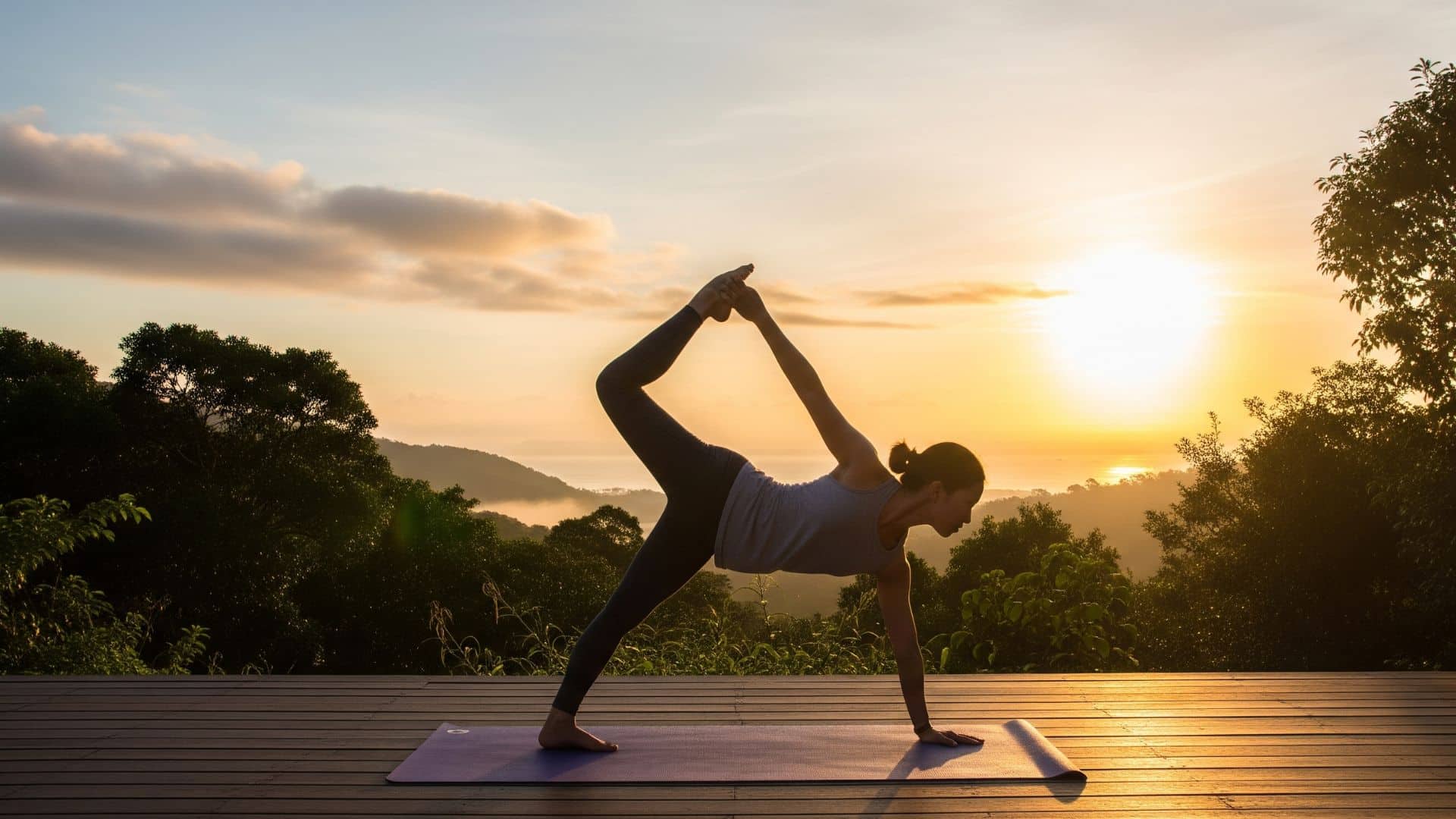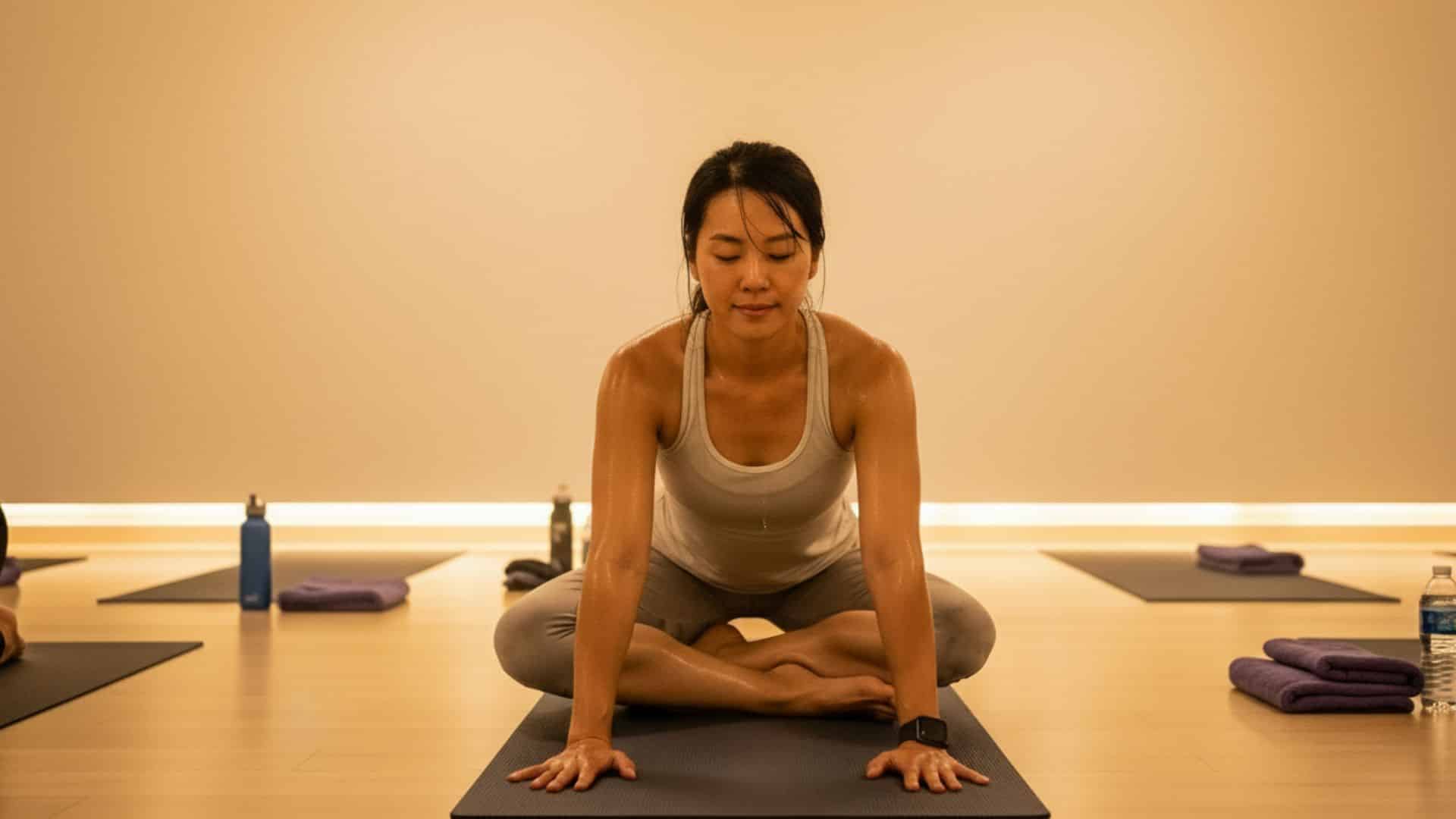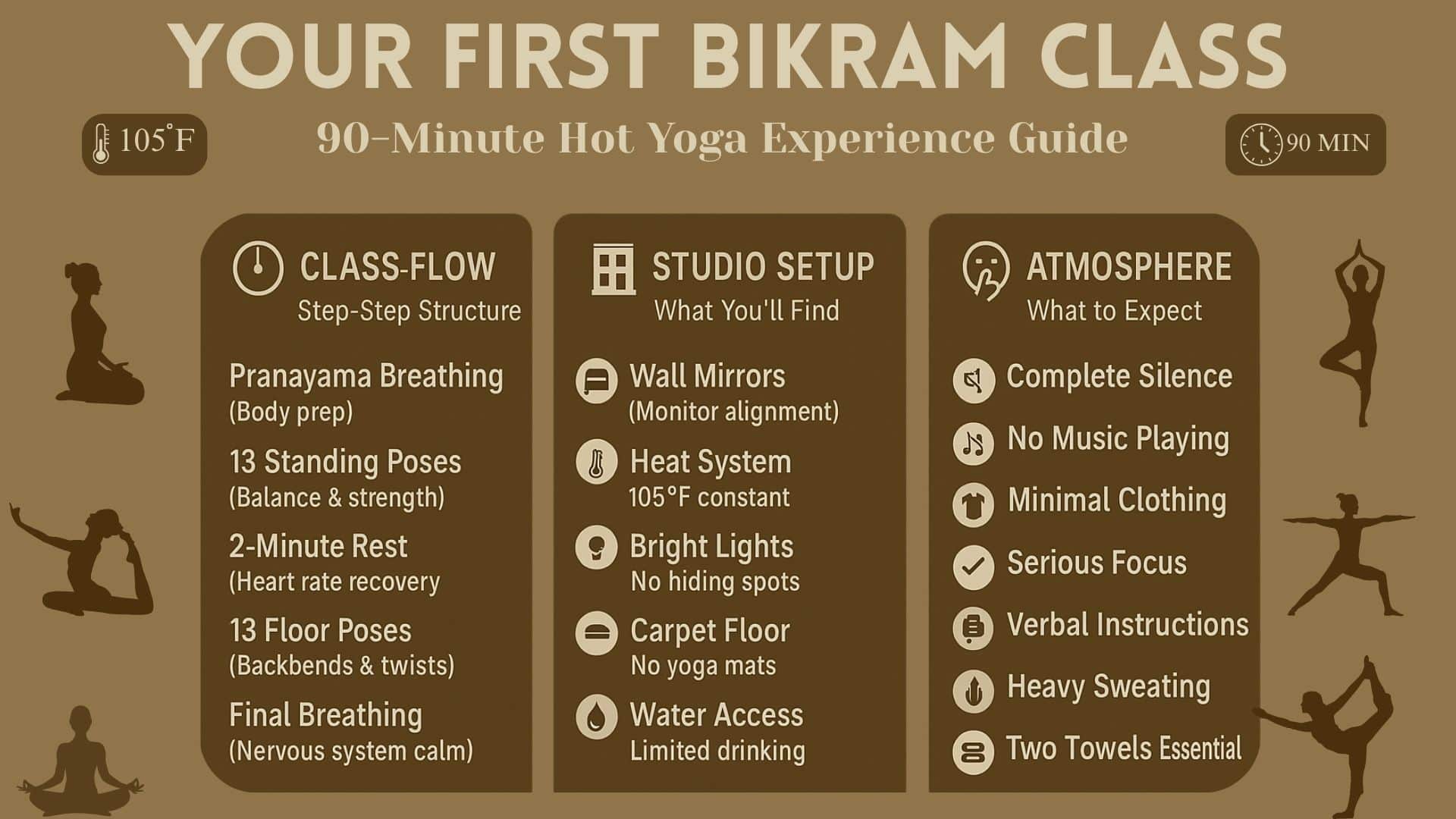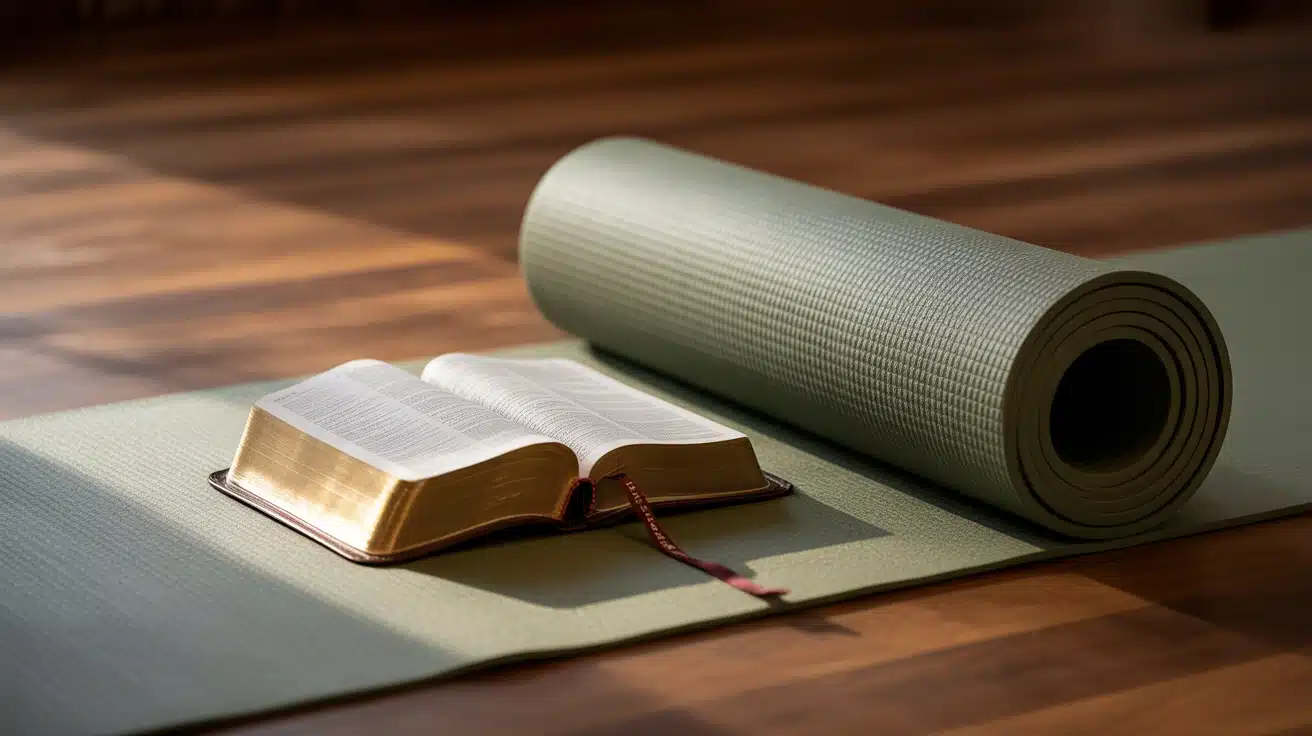Yoga comes in many forms. Some focus on flowing movements. Others emphasize meditation. But few yoga styles create as much heat as Bikram yoga.
This practice stands out from regular yoga classes. It uses extreme heat and a fixed routine. The room temperature reaches 105°F with high humidity.
Bikram yoga follows the same 26 poses in every class worldwide. This consistency makes it different from other hot yoga styles. Many people find the heat initially challenging. Others love how it makes them sweat and stretch deeper.
The practice gained popularity in the 1970s. Today, studios exist in many countries. But what exactly makes Bikram yoga special? Let’s dig into it.
Also Read: What Is Somatic Yoga? A Gentle Path to Inner Calm
What Is Bikram Yoga?
Bikram yoga is a specific style of hot yoga. It takes place in rooms heated to 105°F (40.6°C) with 40% humidity. Every class follows the exact same sequence of 26 postures and 2 breathing exercises.
The heated environment is key to this practice. The heat helps muscles warm up quickly. This allows for deeper stretches and better flexibility. Students hold each pose for specific time periods.
Regular “hot yoga” can vary greatly between studios. Teachers might change poses or sequences. However, true Bikram yoga remains unchanged in its format. The same several poses happen in the same order every time.
Classes last exactly 90 minutes. This allows enough time to complete all poses twice. The routine includes standing poses, floor poses, and breathing work.
The heat makes you sweat heavily. This is considered part of the cleansing process. Many students bring towels and water bottles to stay comfortable.
History and Origins of Bikram Yoga
Bikram yoga has fascinating roots that trace back to India in the 1970s. Bikram Choudhury developed this heated practice and introduced it to Western audiences.
His background in traditional yoga helped shape what millions now practice worldwide.
- Early Training: Choudhury learned traditional Hatha yoga as a child in Calcutta, India
- Master Teacher: His instructor, Bishnu Ghosh, taught him a specific series of poses that became the foundation
- American Debut: Choudhury opened his first U.S. studio in Beverly Hills in 1973
- Rapid Growth: The unique combination of heat and strict routine quickly attracted students
- National Expansion: Success led to studios opening across the United States
- Global Teacher Training: Choudhury trained thousands of instructors worldwide using his exact methods
- Consistency Maintained: All teachers were required to follow identical formats, ensuring the same experience globally
The practice builds upon ancient Hatha yoga principles, incorporating unique elements. Traditional Hatha yoga offers flexibility in sequences and a range of room temperatures.
Bikram yoga requires specific heat levels and follows the exact same poses every time.
This consistency became both its strength and defining characteristic. Students could walk into any certified Bikram studio worldwide and find identical conditions and routines.
5 Core Principles of Bikram Yoga
Bikram yoga is built on five fundamental principles that work together to create its signature experience. These core elements define every aspect of the practice, from room temperature to the sequence of poses.
1. Fixed Sequence
Every Bikram class utilizes the same postures, plus two breathing exercises. The sequence never changes. Students do each pose twice before moving to the next one.
This repetition helps build muscle memory. Students can focus on improving their form instead of learning new poses. The fixed format also allows teachers to provide detailed instructions for each position.
2. Environmental Conditions
Studios maintain a temperature of exactly 105°F with a humidity level of 40%. These conditions help muscles warm up faster. The heat also causes you to sweat, which many believe helps remove toxins.
The humidity prevents the air from feeling too dry. This makes breathing easier than in very hot, dry conditions. Students often need time to adjust to these conditions.
3. Consistency & Progress
The same routine happens worldwide. A class in New York follows the same format as one in Tokyo. This lets students practice anywhere and know what to expect.
Regular students can track their progress more easily. They work on the same poses repeatedly. This helps them notice improvements in flexibility and strength.
4. Alignment and Breathing
Teachers focus heavily on proper form. They give detailed instructions for each pose. Correct alignment prevents injury and increases benefits.
Breathing patterns are also important. Students learn specific breathing techniques. These help them stay calm in the heat and hold poses longer.
5. Mind-Body Connection
The challenging conditions require mental focus. Students must concentrate to withstand the heat and maintain their poses. This builds mental strength along with physical flexibility.
Many students report better stress management. The practice requires being present in the moment. This can help reduce anxiety and improve mental clarity.
Bikram Yoga Class Format: What to Expect?
Starting your first Bikram yoga class can feel overwhelming. The heat, silence, and structured format differ significantly from those of regular yoga studios. This visual guide breaks down exactly what happens during your 90-minute session.
Comprehending the format beforehand helps reduce first-class anxiety. You’ll know what to expect from the moment you walk in. The consistent structure ensures that every Bikram studio worldwide follows the same guidelines.
The infographic illustrates why preparation is crucial for Bikram yoga. The 105°F temperature and silent atmosphere create unique challenges. Knowing the five-step structure helps you pace yourself mentally.
Essential Preparation:
- Arrive 15 minutes early to adjust to the heat
- Bring two towels and wear minimal clothing
- Hydrate before class, limit water during poses
- Expect initial overwhelm – this is normal
The structured format removes guesswork. You’ll do the same poses every class, helping you track progress. The silent environment focuses on alignment and breathing, free from distractions.
Most students need 3-5 classes to adjust. Don’t judge based on your first visit alone. Benefits like flexibility, stress relief, and mental focus grow with regular practice.
Key Benefits of Bikram Yoga
The heated environment and consistent routine of Bikram yoga deliver unique physical and mental benefits that regular yoga practices can’t match, from increased flexibility to enhanced stress relief.
- Increased Flexibility: The heat helps muscles warm up quickly. This allows for deeper stretches than in room-temperature classes. Regular practice can improve flexibility significantly.
- Sweating and Detoxification: Excessive sweating is a common occurrence in every class. Many students believe this helps remove toxins from the body. The process can feel cleansing and refreshing.
- Calorie Burning and Weight Management: The heat makes your heart work harder. This can burn more calories than regular yoga. Some studies suggest that 300-400 calories are consumed per class.
- Stress Relief and Focus: The challenging conditions require complete concentration and focus. This helps quiet mental chatter. Many students report feeling calmer after class.
The consistent routine also reduces decision fatigue. Students don’t worry about what poses come next. They can focus entirely on their practice and breathing.
Bikram Yoga vs Other Yoga Styles
With numerous yoga styles available today, selecting the right practice can be a daunting task. Each style offers different benefits and appeals to different personality types.
Comprehending how Bikram compares to other popular yoga forms helps you make an informed decision about which practice aligns with your goals, preferences, and lifestyle.
| Aspect | Bikram Yoga | Hot Yoga | Vinyasa | Hatha | Ashtanga |
|---|---|---|---|---|---|
| Temperature | 105°F, 40% humidity | Varies (80-100°F) | Room temperature | Room temperature | Room temperature |
| Sequence | Fixed 26 poses | Teacher’s choice | Flowing sequences | Static poses | Fixed series |
| Class Length | 90 minutes | 60-90 minutes | 60-75 minutes | 60-90 minutes | 90+ minutes |
| Music | No music | Often includes music | Usually includes music | Sometimes includes music | No music |
| Flexibility | No variations | Teacher modifications | Many variations | Some variations | Traditional poses only |
| Pace | Slow and steady | Varies | Fast-paced flow | Slow | Fast-paced |
Bikram vs. Hot Yoga: While both utilize heat, Bikram follows strict guidelines for its practice. Hot yoga instructors can select various poses and temperatures. Bikram’s consistency appeals to students who like routine.
Bikram vs Vinyasa: Vinyasa focuses on flowing movement between poses. Bikram holds each position for specific times. Vinyasa is practiced at room temperature, whereas Bikram requires a heated room.
Bikram vs. Hatha: Traditional Hatha yoga encompasses a wide range of poses and variations. Bikram uses only specific postures. The heat makes Bikram more physically demanding than typical Hatha classes.
Bikram vs Ashtanga: Both use fixed sequences, but Ashtanga emphasizes flowing movements. Bikram holds poses longer with breaks between them. Ashtanga builds more cardiovascular fitness while Bikram focuses on flexibility.
The table highlights Bikram’s unique position in the yoga world. Choose based on your preferences for heat, structure, and pace.
Is Bikram Yoga Right for You?
Bikram yoga is best suited for individuals who enjoy heat and a structured routine. If you prefer a consistent structure, this practice may appeal to you. The same sequence every class helps build steady progress.
- People who enjoy hot weather or saunas
- Students who like predictable routines
- Those seeking flexibility improvements
- Practitioners wanting intense physical challenge
Consider carefully if you have:
- Heart conditions or blood pressure issues
- Pregnancy (especially first trimester)
- Heat sensitivity or fainting history
- Dehydration problems
Beginners should start slowly. Take breaks when needed. Drink water before and after class. Listen to your body’s signals about the heat.
Some people find the strict atmosphere off-putting. Others love the discipline it requires. Try a few classes to see if the format suits your personality and fitness goals.
The heat can feel overwhelming at first. Most students need several classes to adjust. Don’t judge the practice based solely on your first experience.
Conclusion
Bikram yoga offers a unique approach to physical and mental wellness. The heated room and fixed sequence create consistent challenges. This helps build both flexibility and mental strength.
The practice appeals to people seeking structure and intensity. Every class follows the same format worldwide. This consistency helps students track progress and build confidence.
The heat makes muscles more flexible while promoting heavy sweating. Many students enjoy this cleansing feeling. The mental focus required can also reduce stress and improve concentration.
If you enjoy routine, heat, and physical challenges, Bikram yoga may be perfect for you.
The practice requires commitment but offers clear benefits. Try a class to see if this hot yoga style matches your fitness goals.










